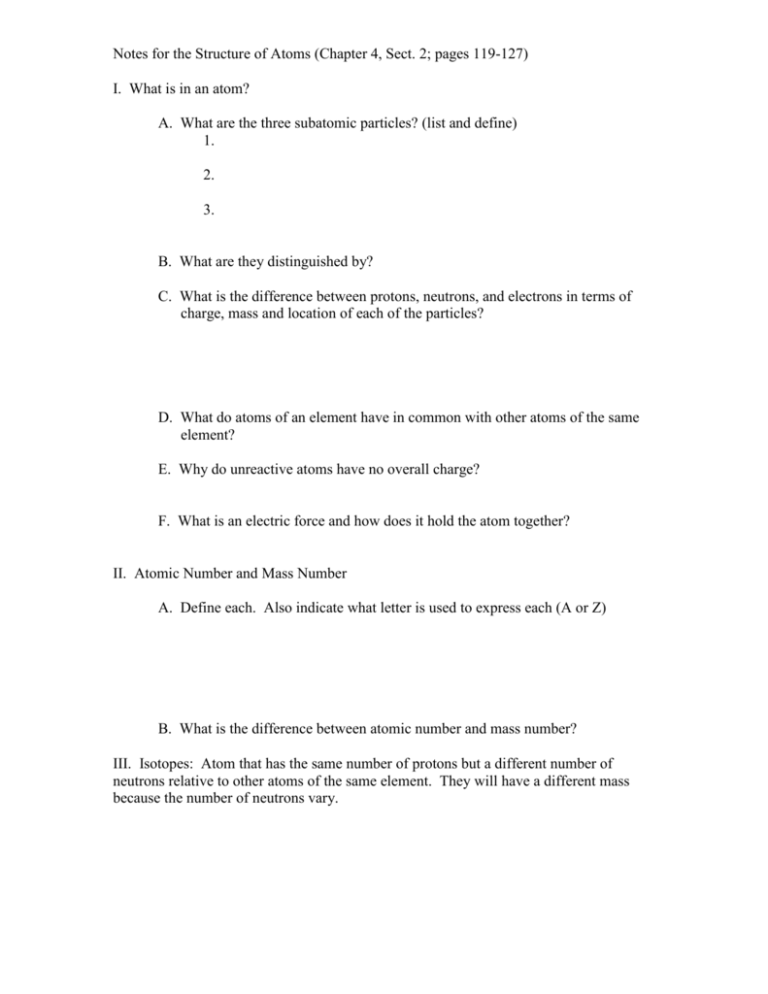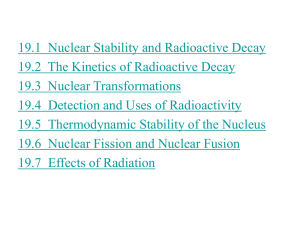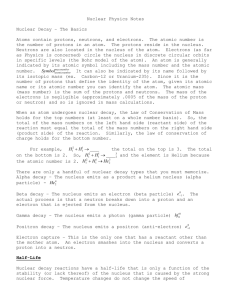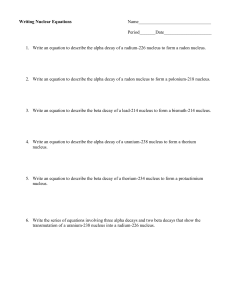Notes for the Structure of Atoms (Chapter 4, Sect
advertisement

Notes for the Structure of Atoms (Chapter 4, Sect. 2; pages 119-127)
I. What is in an atom?
A. What are the three subatomic particles? (list and define)
1.
2.
3.
B. What are they distinguished by?
C. What is the difference between protons, neutrons, and electrons in terms of
charge, mass and location of each of the particles?
D. What do atoms of an element have in common with other atoms of the same
element?
E. Why do unreactive atoms have no overall charge?
F. What is an electric force and how does it hold the atom together?
II. Atomic Number and Mass Number
A. Define each. Also indicate what letter is used to express each (A or Z)
B. What is the difference between atomic number and mass number?
III. Isotopes: Atom that has the same number of protons but a different number of
neutrons relative to other atoms of the same element. They will have a different mass
because the number of neutrons vary.
IV. Radioactivity (chapter 10)
A. Nuclear Radiation:
1. What is Radioactive Decay? – the disintegration of an
unstable atomic nucleus into one or more different nuclides.
After radioactive decay, the element changes into a different
isotope of the same element or into an entirely different
element
2. What is nuclear radiation? release of energy and matter
released from the nucleus during radioactive decay
3. List and define the particles that are emitted during
radiation.
a. alpha particles: positively charged and more massive
than any others. Consists of protons and neutrons.
Doesn’t travel far.
b. beta particles: fast moving electrons (negatively
charged) or positively charged particles (positrons).
{neutrons decay to form protons and electrons, of which
electrons are ejected from the nucleus at a high speed}
move farther than alpha particles but still don’t penetrate
very deep
c. gamma rays: high energy photon (electromagnetic
energy packet) can not easily be stopped.
d. neutron emission: neutrons are emitted from an
unstable nucleus.
B. Nuclear Decay causes changes in the _NUCLEUS________ of an
atom. Anytime…that an unstable nucleus emits alpha or beta
particles, the number of protons and neutrons changes.
1. What happens during gamma decay? – energy in the nucleus
changes but atomic number and mass stay the same
2. What happens during beta decay? – mass number does not
change but atomic number increases by one, causing the atom to
change to a different element.
3. What happens during alpha decay? – mass number and atomic
number change
C. half-life The time it takes for half of a sample of a radioactive
isotope to break down by radioactive decay. Can be a nanosecond
to billions of years.
D. What is the difference between nuclear fission and nuclear fusion? (in regards as
to what happens to the nucleus)
Fission: process by which a nucleus splits into two or more fragments and releases
neutrons and energy. (uranium in power plants)
Fusion: the process in which light nuclei combine at extremely high temperatures,
forming heavier nuclei and releasing energy (hydrogen on the sun)
IV. Radioactivity (chapter 10)
A. Nuclear Radiation:
1. What is Radioactive Decay?
2. What is nuclear radiation?
3. List and define the particles that are emitted during radiation.
B. Nuclear Decay causes changes in the ________________ of an atom. Anytime……
1. What happens during gamma decay?
2. What happens during beta decay?
3. What happens during alpha decay?
C. What is half-life?
D. What is the difference between nuclear fission and nuclear fusion? (in regards as to
what happens to the nucleus)
IV. Radioactivity (chapter 10)
A. Nuclear Radiation:
1. ______________________– the disintegration of an unstable atomic nucleus into one
or more different nuclides. After radioactive decay, the element changes into a
different isotope of the same element or into an entirely different element
2. _______________ _______release of energy and matter released from the nucleus
during radioactive decay
3. List and define the particles that are emitted during radiation.
a. _____________particles: positively charged and more massive than any
others. Consists of protons and neutrons. Doesn’t travel far.
b. ____________ particles: fast moving electrons (negatively charged) or
positively charged particles (positrons). {neutrons decay to form protons and
electrons, of which electrons are ejected from the nucleus at a high speed}
move farther than alpha particles but still don’t penetrate very deep
c. _____________ rays: high energy photon (electromagnetic energy packet)
can not easily be stopped.
d. _________________ emission: neutrons are emitted from an unstable
nucleus.
IV. Radioactivity (chapter 10)
A. Nuclear Radiation:
1. ______________________– the disintegration of an unstable atomic nucleus into one
or more different nuclides. After radioactive decay, the element changes into a
different isotope of the same element or into an entirely different element
2. _______________ _______release of energy and matter released from the nucleus
during radioactive decay
3. List and define the particles that are emitted during radiation.
a. _____________particles: positively charged and more massive than any
others. Consists of protons and neutrons. Doesn’t travel far.
b. ____________ particles: fast moving electrons (negatively charged) or
positively charged particles (positrons). {neutrons decay to form protons and
electrons, of which electrons are ejected from the nucleus at a high speed}
move farther than alpha particles but still don’t penetrate very deep
c. _____________ rays: high energy photon (electromagnetic energy packet)
can not easily be stopped.
d. _________________ emission: neutrons are emitted from an unstable
nucleus.
B. Nuclear Decay causes changes in the __________ ________ of an atom. Anytime…that an
unstable nucleus emits alpha or beta particles, the number of protons and neutrons
changes.
1. What happens during gamma decay? –________________in the nucleus changes but
___________________number and mass stay the same
2. What happens during beta decay? –__________________does not change but
___________________number increases by one, causing the atom to change to a
different____________________.
3. What happens during alpha decay? –_____________number and
_______________number change
C. _____________________ The time it takes for _____________of a sample of a radioactive
isotope to break down by radioactive decay. Can be a nanosecond to billions of years.
D. What is the difference between nuclear fission and nuclear fusion? (in regards as to what
happens to the nucleus)
_______________________: process by which a nucleus splits into two or more fragments
and releases neutrons and energy. (uranium in power plants)
_______________________: the process in which light nuclei combine at extremely high
temperatures, forming heavier nuclei and releasing energy (hydrogen on the sun)
B. Nuclear Decay causes changes in the __________ ________ of an atom. Anytime…that an
unstable nucleus emits alpha or beta particles, the number of protons and neutrons
changes.
1. What happens during gamma decay? –________________in the nucleus changes but
___________________number and mass stay the same
2. What happens during beta decay? –__________________does not change but
___________________number increases by one, causing the atom to change to a
different____________________.
3. What happens during alpha decay? –_____________number and
_______________number change
C. _____________________ The time it takes for _____________of a sample of a radioactive
isotope to break down by radioactive decay. Can be a nanosecond to billions of years.
D. What is the difference between nuclear fission and nuclear fusion? (in regards as to what
happens to the nucleus)
_______________________: process by which a nucleus splits into two or more fragments
and releases neutrons and energy. (uranium in power plants)
_______________________: the process in which light nuclei combine at extremely high
temperatures, forming heavier nuclei and releasing energy (hydrogen on the sun)









